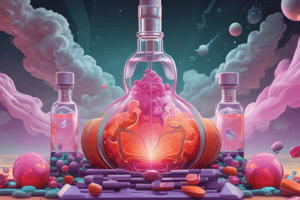Podcast
Questions and Answers
Which of the following describes the phenomenon where the effect of two drugs combined is greater than the sum of their individual effects?
Which of the following describes the phenomenon where the effect of two drugs combined is greater than the sum of their individual effects?
- Additive effect
- Tolerance
- Antagonism
- Synergism (correct)
Which of the following is a characteristic of an orphan drug?
Which of the following is a characteristic of an orphan drug?
- It is a drug that is not effective.
- It is a drug that is only available in certain countries.
- It is a drug that has been withdrawn from the market.
- It is used to treat a rare disease. (correct)
Which of the following is NOT a phase of pharmacokinetics?
Which of the following is NOT a phase of pharmacokinetics?
- Metabolism
- Absorption
- Distribution
- Elimination
- Excretion (correct)
Which route of administration typically results in the fastest onset of action?
Which route of administration typically results in the fastest onset of action?
Which of the following statements accurately describes the relationship between lipid solubility and drug absorption?
Which of the following statements accurately describes the relationship between lipid solubility and drug absorption?
Flashcards
Orphan drug
Orphan drug
A medication developed for rare diseases affecting fewer than 200,000 patients.
Pharmacodynamics
Pharmacodynamics
The study of how drugs affect the body, including mechanisms of action and potency.
Synergism
Synergism
A phenomenon where two drugs work together to produce a greater effect than either would alone.
Agonist
Agonist
Signup and view all the flashcards
Anaphylaxis
Anaphylaxis
Signup and view all the flashcards
Study Notes
Orphan Drug
- A drug designated by regulatory agencies for rare diseases affecting few people
- Often lack commercial viability for companies, so designation encourages development and facilitates access
Pharmacodynamics
- The study of how a drug affects the body and biological processes within it
- Includes how drugs interact with receptors, enzymes, and other cellular targets
- Explains the mechanism of action and effects
- Impacts a drug's efficacy and safety
Ceiling Effect
- A maximum effect a drug can produce, regardless of dosage
- Further increases in dose won't increase the effect
Idiosyncrasy
- A unique and unusual reaction to a drug
- Not related to the drug's typical action
Synergism
- When two drugs together produce an effect greater than their individual effects combined
Additive Effect
- Two drugs together produce an effect equal to the sum of their individual effects
Tolerance
- Decreased responsiveness to a drug over time, requiring higher doses for the same effect
Tachyphylaxis
- Rapid development of tolerance to a drug, often after repeated or short-term use
Anaphylaxis
- Severe, life-threatening allergic reaction to a drug
Adrenergic
- Relating to the effects of the sympathetic nervous system
Antiadrenergic
- Blocking the effects of the sympathetic nervous system
Cholinergic
- Relating to the effects of the parasympathetic nervous system
Anticholinergic
- Blocking the effects of the parasympathetic nervous system
Sympathomimetic
- Mimicking the effects of the sympathetic nervous system
Sympatholytic
- Blocking the effects of the sympathetic nervous system
Parasympathomimetic
- Mimicking the effects of the parasympathetic nervous system
Parasympatholytic
- Blocking the effects of the parasympathetic nervous system
Agonist
- Drug that activates a receptor it binds to
Antagonist
- Drug that blocks a receptor, preventing activation by other substances
Pharmacokinetics (4 Phases)
- Absorption: Drug movement from site of administration into the bloodstream
- Distribution: Drug movement from the bloodstream to the target tissues
- Metabolism: Drug chemical alteration by the body
- Excretion: Drug removal from the body
Origin of Drugs
- Natural sources (plants, animals, minerals)
- Synthetically produced
Sources of Drug Information
- Prescribing information, scientific literature, and clinical guidelines
Advantages of Aerosolized Agents
- Targeted delivery to the lungs, minimizing systemic effects, faster onset of action, and greater precision
How to Breathe When Administering a Treatment
- Inhale slowly and deeply
- Exhale slowly
Therapeutic Index
- Ratio of a drug's toxic dose to its therapeutic dose
- Higher index indicates better safety profile
Mechanisms of Antagonism
- Competitive, non-competitive, and chemical antagonism
Routes of Administration
- Oral, intravenous, intramuscular, subcutaneous, topical, inhalation
Lipid Solubility & Ionization
- Lipid solubility influences absorption and distribution in the body, while ionization affects how readily it passes biological membranes
Autonomic Nervous System
- Part of the peripheral nervous system responsible for involuntary functions
Parasympathetic Nervous System
- Neurotransmitter: Acetylcholine
- Regulated by: Vagus nerve and other cranial nerves
- Receptors: Muscarinic and nicotinic receptors, found in smooth muscle, cardiac muscle, and glands, responsible for resting and relaxing function
Sympathetic Nervous System
- Neurotransmitter: Norepinephrine
- Regulated by: Spinal cord
- Receptors: Adrenergic receptors, found in various tissues, responsible for fight-or-flight response
Beta 2 (B2) activation (Beginning with G Protein activation)
- Ligand (drug) binds to B2 receptor
- Receptor activates G protein (Gs)
- Activated G protein stimulates adenylate cyclase
- Adenylate cyclase converts ATP to cAMP
- cAMP activates protein kinase A (PKA)
- PKA phosphorylates target proteins, leading to cellular effects (e.g., bronchodilation)
Prototype Anticholinergic
- Atropine (acts as a model anticholinergic drug)
Studying That Suits You
Use AI to generate personalized quizzes and flashcards to suit your learning preferences.




